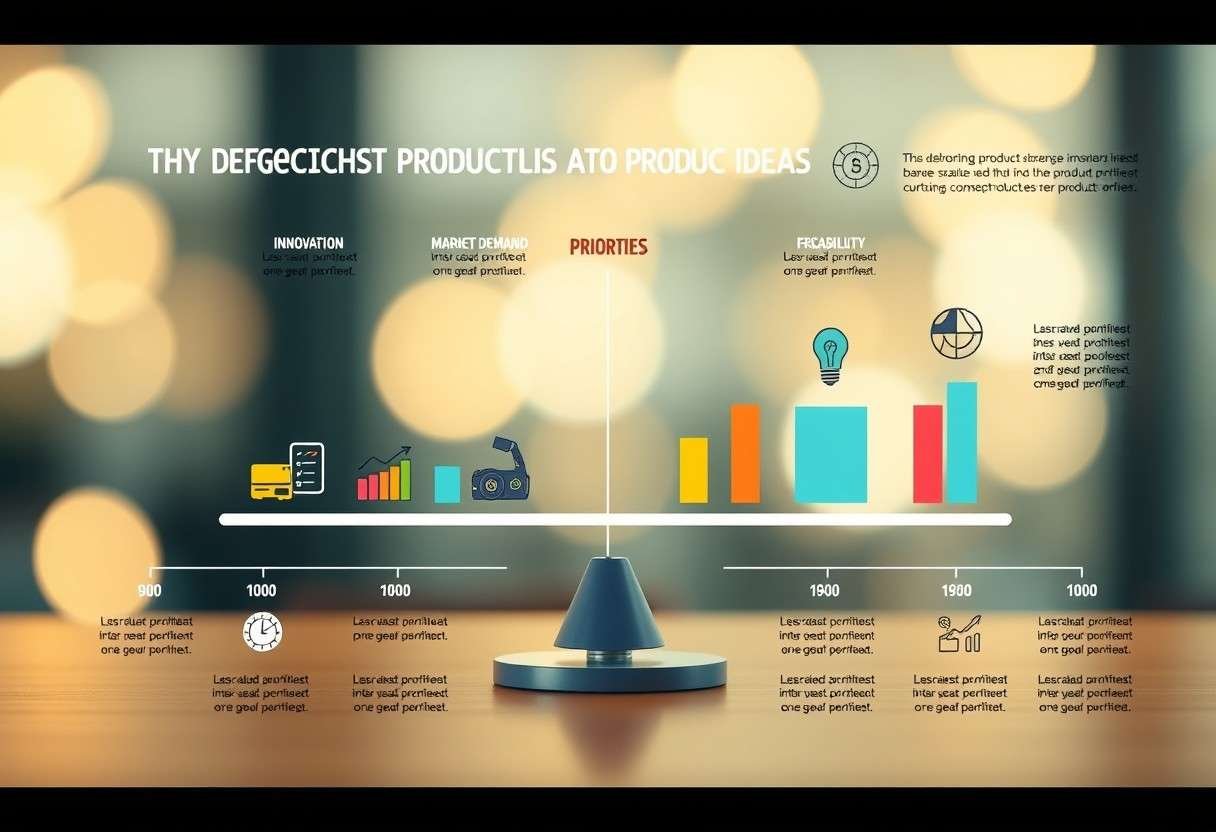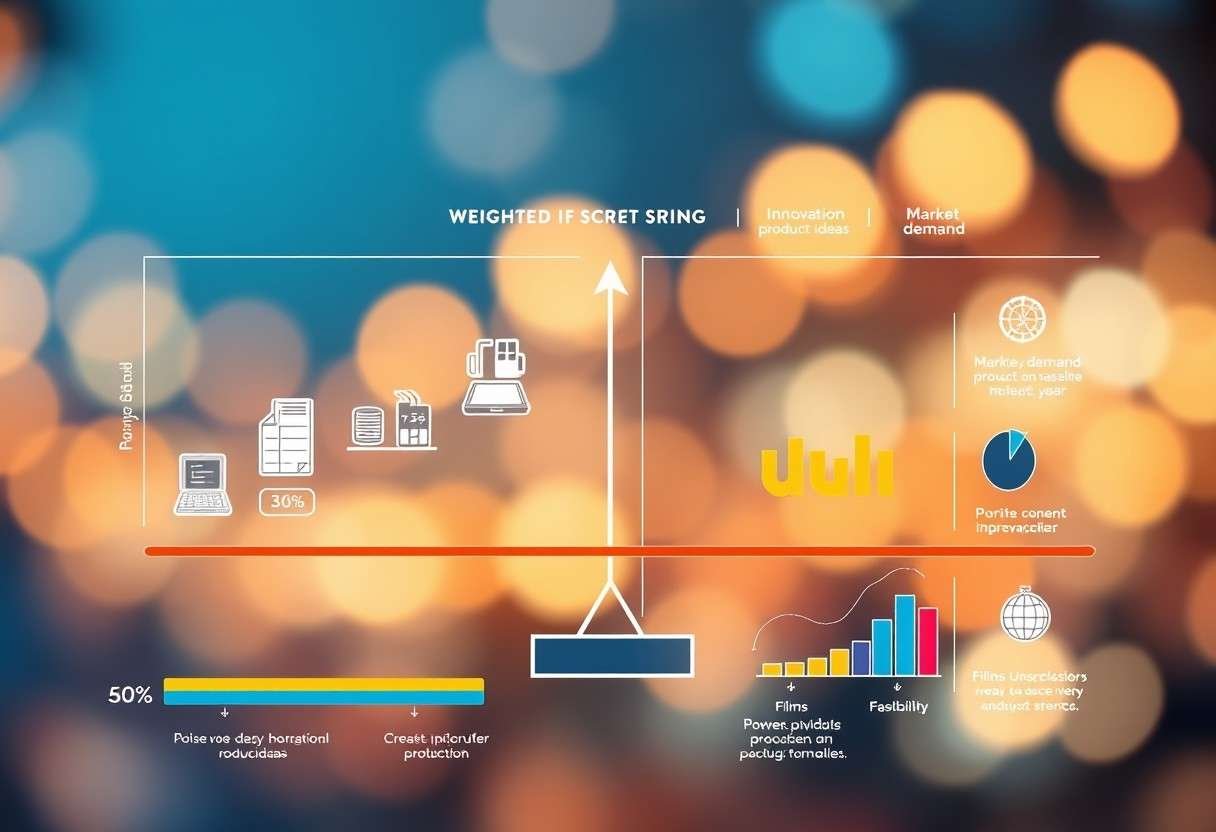Weighted scoring is a valuable tool that empowers you to make informed decisions when ranking your product ideas. By systematically evaluating each idea based on specific criteria, you can identify which opportunities are most likely to succeed in the market. With this strategic approach, you’ll discover how to prioritize your resources effectively, minimizing risk while maximizing potential returns. In this guide, you will learn how to apply weighted scoring to unveil the best product concepts tailored for your goals.

Key Takeaways:
- Weighted Scoring System: This method allows teams to prioritize product ideas by assigning different weights to various criteria, ensuring that the most critical factors are considered in decision-making.
- Objective Evaluation: By quantifying opinions and group feedback, a weighted scoring approach promotes a more objective evaluation of product ideas, reducing bias and improving consensus among team members.
- Strategic Alignment: The scoring process not only ranks ideas but also helps ensure that selected projects align with the overall business strategy and goals, optimizing resource allocation and efforts.
Understanding Weighted Scoring
The process of weighted scoring can seem daunting at first glance, but once you break it down, it becomes a straightforward method for prioritizing various product ideas. It involves assigning weights to different criteria based on their importance, and then scoring your product ideas according to how well they meet those criteria. The final scores help you to make informed decisions by highlighting which product ideas are most likely to succeed based on the factors that matter most to your business objectives.
What is Weighted Scoring?
You begin weighted scoring by defining the criteria crucial for evaluating your product ideas. These can range from market potential to technical feasibility and everything in between. Once you have established your criteria, you assign a weight to each based on its importance to your overall strategy. Each product idea is then scored against those criteria, and the scores are multiplied by their respective weights. Finally, you sum these weighted scores to arrive at a total that will guide your decision-making process.
Benefits of Using Weighted Scoring for Product Ideas
Now that you understand the mechanics behind weighted scoring, let’s explore why it’s beneficial for your product idea evaluation. One of the primary benefits is objectivity; by quantifying qualitative aspects of your product ideas, you minimize biases that could skew your results. This structured approach not only clarifies which ideas align with your strategic goals, but also provides a robust framework that can be shared across your team, creating transparency and a consensus on the decisions made.
Moreover, weighted scoring allows you to make decisions based on data rather than gut feelings. This not only enhances the credibility of your product development process but also enables better resource allocation. As you strategize, you’ll find that weighted scoring can help you identify potential risks and opportunities that you might have otherwise overlooked, ensuring a more comprehensive evaluation of each idea.
Common Misconceptions about Weighted Scoring
There’s a common misconception that weighted scoring is overly complicated or only suitable for large organizations with extensive resources. In reality, anyone can adopt this method, regardless of the size of their team or organization. Additionally, some may mistakenly believe that weighted scoring provides definitive answers or eliminates the need for human judgment. While it does offer a solid foundation for decision-making, the insights derived require your expert input to interpret and act upon.
What many don’t realize is that weighted scoring is meant to be a flexible tool. You have the power to adjust weights and criteria based on evolving business needs or market dynamics. By understanding these nuances, you can maximize the effectiveness of weighted scoring as a critical component of your product development strategy, rather than viewing it as a rigid framework.
Key Factors to Consider
It is vital to identify key factors when strategizing to rank your product ideas effectively. This process will guide your decision-making, helping you prioritize those ideas that align best with your overall vision and objectives. Here are several key factors you should consider:
- Identifying Your Product Goals
- Market Demand and Trends
- Technical Feasibility
- Financial Implications
- User Experience and Feedback
Recognizing the importance of each of these factors will ensure that you engage in a comprehensive evaluation of your product ideas.
Identifying Your Product Goals
Identifying your product goals is crucial to the weighted scoring process. These goals serve as benchmarks that guide your decisions, helping you to align your product ideas with your business’s long-term vision. By clearly defining what you want to achieve—be it increasing user engagement, improving market share, or innovating an existing product—you create a framework for evaluating your ideas more strategically.
Moreover, having clear product goals enables you to assign relevant weights to the scoring metrics. When you understand what is vital for your business’s success, you can appropriately assess each idea’s potential to meet these goals, ensuring that your prioritization process is focused and efficient. If you’re looking for insights on how to approach this step, check out this discussion on Can you share how you are ranking ideas on your boards?.
Market Demand and Trends
Consider the market demand and trends that can significantly influence the viability of your product ideas. Understanding your target audience’s needs and the overall industry landscape can help you gauge the potential success of your concepts. Examine current industry trends, buying behaviors, and competitor offerings. This analysis creates a more informed decision-making process, demonstrating your commitment to addressing consumer needs while staying relevant in the market.
Plus, staying updated on emerging trends not only allows you to capitalize on current demands but also aids in predicting future shifts in consumer preferences. By aligning your product ideas with these trends, you can ensure they resonate more effectively with your audience, enhancing their likelihood of success.
Technical Feasibility
Now, it’s important to assess the technical feasibility of your product ideas. This evaluation involves considering your available resources, including technology, skill sets, and team capacity. Identifying potential roadblocks, such as the need for new tools or specialized expertise, will help you determine whether your ideas can realistically be executed within your planned timeline and budget.
Market dynamics can also play a role in your assessment of technical feasibility. For instance, are there technological advancements that could either facilitate development or render your concept obsolete? By recognizing how these factors interplay, you can establish a clearer understanding of which ideas are achievable.
Financial Implications
Implications of your decisions should also be grounded in the financial aspects of your product ideas. Evaluating the costs associated with development, marketing, and distribution is vital for ensuring your project’s long-term sustainability. You want to ensure that the expected return on investment (ROI) aligns with your business objectives and justifies the investment.
With a thorough financial analysis, you can avoid pursuing ideas that might drain resources without promising a viable return. This knowledge will empower you to prioritize projects that not only meet market demands but also fit within your financial constraints.
User Experience and Feedback
For any product idea, user experience and feedback are instrumental in its success. Engaging with your target audience through surveys, focus groups, or beta testing can provide you with insights on how your ideas resonate with potential users. By prioritizing user experience, you’ll foster greater acceptance and satisfaction, ultimately enhancing your product’s market performance.
A proactive approach to gathering feedback can uncover hidden flaws in your product concepts. By addressing these issues early in the development process, you can make necessary adjustments that lead to stronger outcomes and happier customers.
Setting Up Your Weighted Scoring System
Keep in mind that a well-structured weighted scoring system can significantly enhance your decision-making process when it comes to product ideas. By implementing a methodical approach, you can objectively evaluate the merits and drawbacks of each potential project, thereby paving the way for informed innovation and strategic resource allocation.
Defining Criteria for Scoring
One of the first steps in establishing your weighted scoring system is to define the criteria for scoring. These criteria should reflect what is most important for the success of your product ideas, including factors such as market demand, potential revenue, development cost, and alignment with business goals. Your criteria should also incorporate any industry-specific requirements that may apply to your projects. The goal here is to create a comprehensive list that captures all critical aspects of your product ideas.
As you compile your criteria, it’s crucial to involve relevant stakeholders in the process to gain diverse perspectives. This collaborative approach not only helps ensure that you cover all bases, but it also fosters a sense of ownership among your team members as they see their insights being valued in the decision-making framework.
Assigning Weights to Criteria
To prioritize the criteria you have created, you will need to assign weights to each of them. This process involves determining the importance of each criterion relative to the others. Consider utilizing a scale (e.g., 1 to 5 or 1 to 10) to rate the significance of each criterion based on your objectives and strategy.
With the weights established, you can now effectively differentiate between what matters most to your product’s viability and potential success. This not only helps streamline your evaluation process but also allows you to focus your resources and efforts where they will have the most impact.
Creating a Scoring Matrix
One of the most practical tools for visualizing your weighted scoring system is the scoring matrix. You can create a matrix where the rows replicate your defined product ideas and the columns reflect the criteria you specified earlier. Each cell within the matrix will be filled with the scores corresponding to how well a product idea meets each criterion.
Criteria need to be clear and measurable, enabling you to assign scores based on defined performance levels. By summing the weighted scores across all criteria for each product idea, you will ultimately derive a total score that will facilitate straightforward comparisons. This will allow you to identify and rank your best ideas based on objective evaluation rather than subjective bias.
How to Apply the Weighted Scoring Method
Not only is the weighted scoring method an effective way to prioritize your product ideas, but it’s also incredibly straightforward to implement. To get started, you want to ensure you have a clear understanding of the criteria that matter most to your product development process. For a deeper examine the framework, refer to RFP Weighted Scoring Demystified: How-to Guide and ….
Collecting Data for Each Product Idea
Each product idea you’re considering should have relevant data associated with it. This may include market research, customer feedback, and competitive analysis. By gathering as much detail as you can, you create a data set that will inform your scoring. More importantly, you can determine which ideas justify investment based on qualitative and quantitative metrics. Ensure you’re thorough; the depth of your data can greatly influence your end results.
Additionally, it’s crucial to keep in mind the various aspects of each idea that may affect its success. For example, consider technical feasibility, customer impact, and return on investment. The more comprehensive your dataset, the better foundation you’ll have for making informed decisions about your product ideas.
Scoring Your Ideas Based on Defined Criteria
While you assess your product ideas, you must score each one based on pre-defined criteria that reflect your organizational goals and customer needs. This step requires you to be objective and systematic in your approach. Each criterion should carry a weight that expresses its importance to your overall product strategy, allowing you to assign scores that truly reflect the potential value of each idea.
Understanding how to assign scores for both qualitative and quantitative attributes will enhance the robustness of your evaluation. Most importantly, you want to ensure that your scoring mechanism remains flexible enough to adapt to new insights, while still providing a clear structure to your decision-making process.
Analyzing the Results
Any effective application of the weighted scoring method culminates in a thorough analysis of the results. This is your opportunity to interpret the scores and assess which product ideas are likely to yield the best outcomes for your business. By carefully reviewing the data, you can identify patterns and make strategic decisions that align with your business objectives.
Data-driven analysis not only helps you to visualize where the greatest opportunities lie but also minimizes the risk associated with your decisions. If you identify an idea that scores significantly higher than others, it allows you to allocate resources accordingly, giving you a strategic edge in your product development endeavors.
Tips for Effective Ranking
Once again, utilizing a structured approach is key when it comes to branching out your idea ranking. Here are some tips to help you streamline the weighted scoring process for your product ideas:
- Ensure your criteria are aligned with overall business strategies.
- Involve key stakeholders to enhance consensus.
- Set a clear framework for scoring to eliminate biases.
- Periodically revisit and adjust your rankings.
- Document your process for transparency.
The ability to effectively rank your product ideas can enhance your decision-making process and contribute to your company’s success. For more insights and guidance, refer to this Weighted Scoring Model in Product Management: A Guide.
Engaging Your Team in the Process
Assuming you want your ranking process to be effective, it is crucial to actively engage your team throughout the process. Involving team members not only cultivates a sense of ownership but also brings a variety of perspectives that can enrich the scoring process. Make sure to allocate time for team discussions and brainstorming sessions, as collaboration can lead to more innovative solutions and a well-rounded evaluation of your ideas.
Fostering an inclusive environment where everyone feels comfortable sharing their thoughts will help surface valuable insights. Remember that each team member may have different criteria that matter to them; it’s vital to embrace those diverse viewpoints as they can provide a comprehensive understanding of what makes an idea truly viable for your market.
Keeping Your Scoring Adaptive
Engaging with new information is fundamental to keeping your scoring system adaptive. As you accumulate feedback and learn more about your business landscape, be prepared to revisit your scoring criteria and adjust where necessary. The market’s dynamics can shift rapidly, and staying flexible ensures that your scoring remains relevant and accurate, reflecting any changes in business priorities or market conditions.
Additionally, using data and analytics can further refine your scores. Make sure to leverage qualitative and quantitative insights to inform your decisions as you adapt your ranking process. You will find that being open to change not only enhances the integrity of your decisions but also positions you better against competitors.
Validating Scores with Real-World Feedback
Your scoring isn’t final until it stands up against real-world feedback. After prioritizing your product ideas through the weighted scoring model, it’s vital to seek validation from potential customers or stakeholders. Engaging these groups can provide crucial insights about which ideas resonate most and highlight any potential pitfalls in your rankings, ensuring your priorities reflect the true market demands.
Seeking feedback through surveys, focus groups, or beta testing doesn’t just confirm your rankings; it also strengthens your relationships with potential users, fostering a community that feels invested in your product’s success. By integrating their feedback into your process, you are likely to refine your product ideas significantly.
The success of your ranking process hinges on continual validation and adaptation. By making real-world feedback a cornerstone of your strategy, you can pivot quickly and maintain alignment with user expectations and market trends.
The importance of revisiting and refining your scoring mechanisms cannot be overstated. By valuing real-world inputs and remaining flexible, you enhance your chances of making informed decisions that truly reflect market necessities.
Avoiding Common Pitfalls
For anyone looking to implement a weighted scoring system for product idea evaluation, it’s necessary to be aware of prevalent pitfalls that can undermine your efforts. By avoiding these common mistakes, you will ensure that your ranking process is effective, strategic, and ultimately, beneficial to your product development journey.
Overcomplicating the Scoring System
Even though a detailed scoring system might seem appealing, overcomplicating it can lead to confusion and inefficiency. You want to create a scoring model that is easy to understand and implement. When you add too many criteria, it can dilute focus and make it hard to reach a consensus among team members. Stick to a few key metrics that truly matter to your decision-making process.
Furthermore, when you convolute the scoring process with intricate calculations or unnecessary variables, you may inadvertently discourage participation from your team. A straightforward system increases buy-in and encourages collaboration, making it simpler for everyone to contribute towards achieving your collective goals.
Ignoring Stakeholder Input
Even if you are passionate about your product ideas, it’s crucial not to overlook the insights of other stakeholders. By ignoring feedback from your team, customers, and partners, you risk developing a skewed perspective that may not accurately reflect market dynamics or user needs. Involving diverse viewpoints can bring new insights that help refine scoring criteria, ultimately leading to more informed decisions.
The importance of stakeholder input cannot be overstated; it enhances the credibility of your scoring rankings and mitigates biases that may exist from a singular viewpoint. By engaging with various stakeholders throughout the evaluation process, you create an inclusive environment that fosters innovation and sound judgment.
Failing to Reassess Over Time
Now that you have established a weighted scoring system, it’s important to remember that this framework isn’t static. Over time, market conditions, customer preferences, and development goals can shift dramatically. By failing to reassess your scoring system, you risk ignoring vital changes that could impact your strategic decisions.
Plus, regularly revisiting your scoring model allows you to refine your criteria based on performance and feedback. This practice not only keeps your evaluation process relevant but also continuously enhances your decision-making capabilities, ensuring that your product ideas remain aligned with evolving objectives and market demands.

To wrap up
Considering all points, implementing a weighted scoring model can significantly enhance your decision-making process when it comes to ranking your product ideas. By assigning distinct weights to various criteria, you’re able to ensure that your evaluation is not only systematic but also aligned with your strategic objectives. This method empowers you to prioritize opportunities that resonate most with your vision and market demands, ultimately steering your product development efforts in a focused direction. Bear in mind, the clarity you gain from this approach will positions you to make informed choices, reducing the time and resources spent on less promising ideas.
Moreover, incorporating feedback and iterating on your scoring criteria as your business and market landscape evolves will only refine your strategy further. This agility allows you to stay ahead of industry trends and customer preferences, ensuring that your product offerings remain relevant and competitive. By embracing weighted scoring, you take a proactive step towards fostering innovation within your organization, leading to more impactful outcomes for your customers and stakeholders alike. So, as you commence on this journey, trust the process, and leverage this strategic tool to bring your best product ideas to life.
FAQ
Q: What is weighted scoring and how does it help in ranking product ideas?
A: Weighted scoring is a systematic approach used to evaluate and prioritize product ideas based on multiple criteria. It involves assigning weights to various factors that are important for decision-making, such as market potential, feasibility, cost, and alignment with business goals. By quantifying these criteria, teams can score each product idea, making it easier to determine which ideas are worth pursuing further. This method helps in focusing resources on the most promising concepts and reduces the chances of bias in decision-making.
Q: How do I determine the criteria and weights to use for my product ideas?
A: To determine the criteria to evaluate your product ideas, start by identifying the strategic objectives of your business. Common criteria can include market demand, competitive advantage, customer feedback, technological feasibility, financial viability, and alignment with company vision. Once you have defined your criteria, you can assign a weight to each based on its importance relative to your objectives. This weight should reflect how critical that criterion is for the overall success of the product. Engaging stakeholders in this process can help ensure a well-rounded perspective on what factors are most significant.
Q: Can weighted scoring be applied to both new product development and feature prioritization?
A: Yes, weighted scoring is versatile and can be effectively applied to both new product development and feature prioritization. In the context of new product development, it helps teams evaluate various product concepts against strategic criteria to identify the most promising options. When prioritizing features for an existing product, you can use weighted scoring to assess each feature’s potential impact, user demand, development effort, and alignment with product goals. By applying weighted scoring in both scenarios, organizations can ensure a consistent and objective approach to decision-making and resource allocation.







